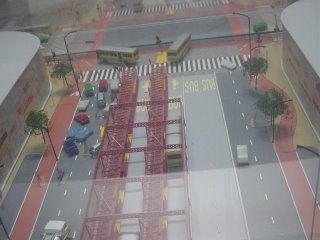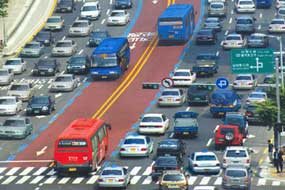An entrance to the Delhi Metro in the midst of Old Delhi
This is an edited version of a posting I made this morning on the
sustran-discuss email discussion group in response to a discussion there over public transport options that was sparked by the news of
Chennai's debate over Monorail. The debate has included examples from Malaysia, Thailand, the USA, Hong Kong and Singapore.
Four key issues have emerged in the discussion that seem particularly important to me.
ONE - CONSIDER ALTERNATIVES, NOT JUST ONE PROPOSAL:The specific mass transit technology gets a lot of attention but is often beside the point. If ALL reasonable options were fairly evaluated on a level playing field, some corridors would merit ordinary bus, some BRT, some LRT, some Metro (and perhaps some rare cases might even suit monorail?). Unfortunately, unsolicited proposals from purveyors of specific options often get evaluated in isolation.
A model in the TRIPP office of Delhi's yet-to-be-realised
High Capacity Bus System (HCBS), including kerbside NMV lanes

TWO - CONSIDER URBAN STRUCTURE IMPLICATIONS:The criteria for evaluation must be framed with a keen awareness of the long-term land-use futures that are implied or assumed in each option. The implications for the future structure of the city are rarely an explicit part of the evaluation.
These urban structure alternatives need to be more often an explicit part of the debate. Singapore was mentioned yesterday as an exception. In the MRT debate in Singapore which took place in the 1970s and early 1980s, different expectations (and normative views) about the role of the city centre (number of jobs in CBD) became one of the central issues in choosing between MRT against the express buses on expressways option, which assumed and would have supported more dispersed employment.
Dinesh Mohan of
TRIPP at IIT-Delhi once argued to me that numerous, middle-density BRT-based corridors would be more sustainable for Delhi (building on its existing structure) and would allow more affordable housing for the poor, than a small number of very dense (with expensive real estate) MRT-based corridors.
THREE - ECONOMIC VIABILITY, NOT FINANCIAL VIABILITY:How do we judge 'success' of a mass transit system? There seem to be various perspectives here, resulting in some muddle I think. Some have implied that financial success is the key. This might be reasonable IF road transport was paying its full costs AND mass transit projects could capture their external benefits (especially in the form of property value increments). In reality these are never (rarely?) the case. In any case, fares should not be expected to cover the fixed infrastructure costs. This is because scale economies in most mass transit means that marginal cost pricing will never cover the full cost. In all conditions except an extreme crush load, the marginal cost of an extra passenger is always less than the average cost per passenger.
It is ECONOMIC viability NOT FINANCIAL viability that must be the test. Public sector investment in the fixed assets of mass transit can be justified, provided it is subjected to the best cost-benefit analysis we can manage (various problems with real-world CBA notwithstanding!). This is why it is a common model for government to build the fixed asset then contract out the operations (eg in
Singapore). The World Bank Urban Strategy review document, '
Cities on the Move' (pages 121 and 122 for example) is worth a look on this point.
It is therefore extremely surprising that anyone ever tries to build capital-intensive forms of mass transit with private finance alone, as has been tried in Bangkok and Kuala Lumpur. This argument provides circumstantial evidence therefore that Karl is probably right in saying that the investors in projects like
KL's LRT systems were bearing few of the risks, and cynically expected to be bailed out. Yes, it would have been better to get the public/private mix correct from the start. But it also means that it is overly harsh to say that a mass transit system has 'failed' its city if it cannot cover its capital costs from fares.
FOUR - NEED TO BE POLITICALLY AWARE: Despite all the rational planning notions that I have drawn on above, in reality, politics and power play a key role in these decisions. We cannot ignore the political economy of urban transport.
We can see this in many of the examples
mentioned in the last few days on sustran-discuss. Rational analysis and evaluation is one tool in the game but it is often trumped by other tools (eg rallying public opinion, lobbying politicians, sweetening a deal with bilateral aid, etc) that are often wielded in the narrow interest of one powerful group or another.
So should we drop the analytical tools and just play the politics, focusing on winning the rhetorical battles? I don't think so. But it is probably naïve to think that the public interest and sustainable development aspirations will win out with rational planning alone. We need to be politically aware even as we appeal to careful analysis (AND scrutinise any evaluations that seem to be skewed by vested interests).
We should oppose politically driven disasters but may sometimes need to pragmatically support sub-optimal (but politically viable) projects that are better than the other politically possible alternatives (such as no improvement at all, or flyovers and expressway building). Telling the difference is not so easy however.
For some on the sustran-discuss list, such Metros seem to be a politically viable alternative to having no improvement to public transport at all, and provide a politically vital demonstration that public transport, not expressways, can be the attractive 'modern' centrepiece of urban transport, and need not be just for the poor. Some also argue that Metro's help bring about the land use structures that are more sustainable in the long run.
For others, metros in low-income countries (such as the Delhi Metro) smack of a disastrous white elephant with tragic opportunity costs, stealing scarce investment funds that could do so much more if pumped into BRT. Worse, some see Metros as part of avoiding difficult choices over space allocation ('we can't do BRT if it means taking lanes from general traffic'), and might actually complement a sprawling, private-vehicle-based transport system in the long-run.
Who is right? I don't know.



